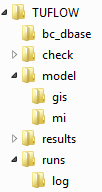TUFLOW CATCH Tutorial M01 Draft
Page Under Construction
Introduction
In this module, a TUFLOW CATCH pollutant export model is developed.
TUFLOW CATCH Tutorial Module 1 build from the model created in TUFLOW Tutorial Module 6 - Part 3. The completed TUFLOW Module 6 (part 3) is provided in the TUFLOW_CATCH_Module_01\Modelling folder of the download dataset as the starting point for this tutorial. If you are not already familiar with TUFLOW, we recommend first completing Module 1, 2, 3 and 6 of the TUFLOW Tutorials to establish an understanding of 1D and 2D TUFLOW modelling, as well as direct rainfall models.
Project Initialisation
TUFLOW CATCH models are separated into a series of folders which contain the input and output files. The recommended set up for the model directory and sub-folders is shown below. The top level folder should be called Modelling and contain three subfolders: TUFLOW, TUFLOWCatch and TUFLOWFV. more info?? For a more detailed description, refer to the TUFLOW CATCH Manual.
| Folder | Sub-Folder | Description |
|---|---|---|
| TUFLOW | bc_dbase | Contains TUFLOW boundary condition database(s) and input time-series data. |
| catch | ??? | |
| check | Not used, but produced? for consistency. All TUFLOW check files are written to the TUFLOWCatch\check folder. | |
| model | Contains the .tgc, .tbc and other TUFLOW model control files, except for the layers and grid inputs which are located in the model\gis folder and model\grid folders respectively. | |
| model\gis | Contains the TUFLOW GIS vector layers. | |
| model\grid | Contains the GIS raster layers | |
| results | Not used, but produced? for consistency. All TUFLOW result files are written to the TUFLOWCatch\results folder. | |
| runs | Not used, but produced? for consistency. TUFLOW CATCH simulations are run from the .tcc file in the TUFLOWCatch\runs folder. | |
| TUFLOWCatch | bc_dbase | Contains the output boundary condition and time-series data. |
| check | Contains the GIS and other check files produced by TUFLOW CATCH, TUFLOW and TUFLOW FV to carry out quality control checks | |
| model | ?? | |
| model\gis | ?? | |
| results | Contains the result files produced by TUFLOW CATCH, TUFLOW and TUFLOW FV. | |
| runs | Contains the .tcc simulation control file. | |
| runs\log | Contains the log files (e.g. .catchlog, .tlf, .log, etc) and _messages.shp files produced by TUFLOW CATCH, TUFLOW and TUFLOW FV. | |
| TUFLOWFV | bc_dbase | Contains TUFLOW FV boundary conditions, often with additional sub-folders for specific boundary condition types (e.g. meteorology: bc_dbase\met). |
| check | Not used, but produced? for consistency. All TUFLOW FV check files are written to the TUFLOWCatch\check folder. | |
| model | ??? | |
| model\csv | ??? | |
| model\geo | Contains the GIS raster layers and the model mesh. | |
| model\gis | Contains the TUFLOW FV GIS vector layers. | |
| results | Not used, but produced? for consistency. All TUFLOW FV result files are written to the TUFLOWCatch\results folder. | |
| runs | Not used, but produced? for consistency. TUFLOW CATCH simulations are run from the .tcc file in the TUFLOWCatch\runs folder. | |
| stm | Contains the sediment transport module files. | |
| wqm | Contains the water quality module files. |
The TUFLOW CATCH folder can be set up manually, or automatically through the link TUFLOW CATCH QGIS Plugin.
GIS Inputs
Create, import and view input data:
TUFLOW Boundary Condition Database (bc_dbase)
Update the bc_dbase with a reference to the timeseries temperature data:
- In Windows File Explorer, navigate to the TUFLOW_CATCH_Module_01\Tutorial_Data folder. Copy the temperature.csv and paste it in the TUFLOW_CATCH_Module_01\Modelling\TUFLOW\bc_dbase folder. This file contains the timeseries temperature data.
- Open the file. As this file will be read by TUFLOW CATCH, the first column must contain the date in isodate format (DD/MM/YYYY hh:mm:ss). It will also be read by TUFLOW HPC, and therefore must have column specifing time in hours from beginning of the model. In this case, the 'TUFLOW_Time' column contains the time in hours. For example, 01/01/2021 10:00:00 corresponds to 0, 01/01/2021 11:00:00 to 1, and so on.
File:Image of temp.csv
- In the Modelling\TUFLOW\bc_dbase folder, save a copy of the bc_dbase_M06_001.csv as bc_dbase_TC01_001.csv.
- Open the file and add the reference to the timeseries temperature data as shown below:
File:Image of bc dbase
- Save the bc_dbase.
Materials
Surface roughness or bed resistance values (e.g. Manning’s n) are assigned to material IDs. To simulate a more complex catchment area, more material IDs have been specified.
- In Windows File Explorer, navigate to the TUFLOW_CATCH_Module_01\Tutorial_Data folder. Copy the materials_TC01_001.csv and paste it in the TUFLOW_CATCH_Module_01\Modelling\TUFLOW\model folder. This file is a modified version of materials_M06_002.csv from TUFLOW Tutorial Module 6.
- Open the file. Roughness values (Manning's n) have been applied to the five new material IDs:
File:Image of mat file
- These new material IDs will each have different pollutant export properties. This is why a different ID has been assigned to each paddock. talk about what is on each paddock>>
TUFLOW Soil File (.tsoilf)
Simulation Control Files
TGC
TBC
ECF
TCC
Running the Simulation
Troubleshooting?
